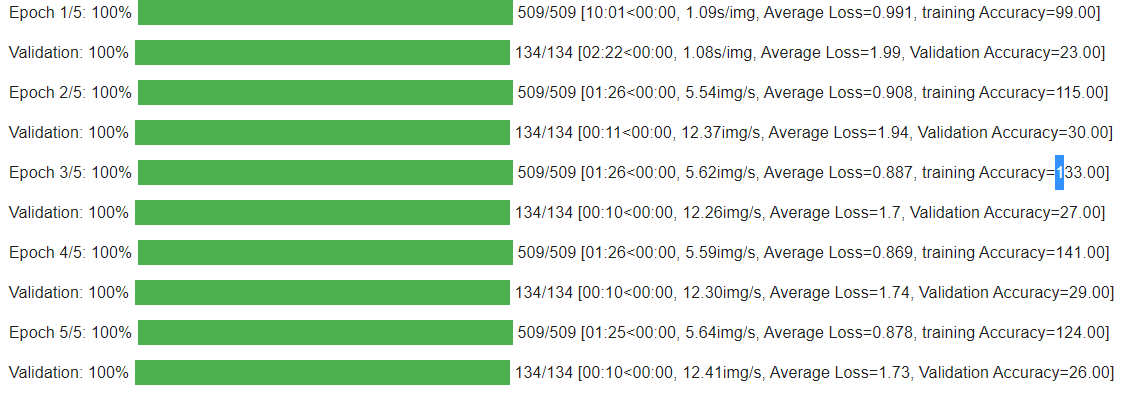This is my code for traning and validation loop. Please help me with this issue.
model = get_pretrained_model('inceptionv3')
#print(model.forward)
device = torch.device('cuda' if torch.cuda.is_available() else 'cpu')
model = model.to(device)
criterion = torch.nn.CrossEntropyLoss()
n_class=5
optimizer = torch.optim.Adam(model.parameters())
scheduler = torch.optim.lr_scheduler.ReduceLROnPlateau(optimizer, 'min' if n_class > 1 else 'max', patience=2)
#training and validation
totEpochs = 5
for ep in range(totEpochs):
# Training loop
epoch_loss = 0
train_acc=0
valid_acc=0
with tqdm(total=len(trainset), desc=f'Epoch {ep + 1}/{totEpochs}', unit='img') as pbar:
for batch in trainLoader:
img = batch['image'].to(device)
label = batch['label'].to(device)
#depth = batch['depth']
net_pred = model(img)#,depth.unsqueeze(1))
loss = criterion(net_pred[0], label)
epoch_loss += loss.item()
pbar.set_postfix(**{'Loss (Batch)': loss.item()})
optimizer.zero_grad()
loss.backward()
nn.utils.clip_grad_value_(model.parameters(), 0.1)
optimizer.step()
# Calculate training accuracy
pred = torch.argmax(net_pred[0], dim=1)
correct_tensor = pred.eq(label)
# Need to convert correct tensor from int to float to average
accuracy = torch.mean(correct_tensor.type(torch.FloatTensor))
# Multiply average accuracy times the number of examples in batch
train_acc += accuracy.item() * img.size(0)
pbar.update(img.shape[0])
pbar.set_postfix(**{'Average Loss': epoch_loss/len(trainset), 'training Accuracy': f'{train_acc:.2f}%'})
#pbar.set_postfix(**{'training Accuracy': f'{train_acc:.2f}%'})
# validation loop
val_loss = 0
with tqdm(total=len(valset), desc=f'Validation', unit='img') as pbar:
for batch in validLoader:
with torch.no_grad():
img = batch['image'].to(device)
label = batch['label'].to(device)
#depth = batch['depth']
net_pred = model(img)#,depth.unsqueeze(1))
loss = criterion(net_pred[0], label)
val_loss += loss.item()
pbar.set_postfix(**{'Loss (validation)': loss.item()})
#calculate validation aaccuracy
pred = torch.argmax(net_pred[0], dim=1)
correct_tensor = pred.eq(label)
accuracy = torch.mean(correct_tensor.type(torch.FloatTensor))
# Multiply average accuracy times the number of examples
valid_acc += accuracy.item() * img.size(0)
pbar.update(img.shape[0])
scheduler.step(val_loss / len(valset))
pbar.set_postfix(**{'Average Loss': val_loss / len(valset), 'Validation Accuracy': f'{valid_acc:.2f}%'})
#pbar.set_postfix(**{'Validation Accuracy': f'{valid_acc:.2f}%'})
#print(f'\t\tTraining Accuracy: {train_acc:.2f}%\t Validation Accuracy: {valid_acc:.2f}%')
